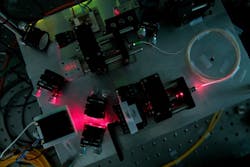Fiber-optic quantum-key distribution technique perfectly times photons' arrival
Taking advantage of existing underground fiber networks to transmit entangled photons is essential for deploying practical quantum-key distribution (QKD) systems, which will create encryption keys for secure communication that is resistant to all computational hacks. Researchers at the National University of Singapore (NUS) and Singtel (both in Singapore) have demonstrated a technique that will help pairs of entangled photons smoothly navigate these networks.1
The project is driven by the NUS-Singtel Cyber Security Research & Development Laboratory, a public-private partnership supported by the National Research Foundation, Prime Minister's Office, Singapore.
The QKD trials carried out by the NUS-Singtel team use pairs of photons that are connected via entanglement. Most QKD schemes require that the sender and receiver of a secret message exchange photons directly or trust the source of their keys. With this alternative approach, it is possible to check the security of a key provided by a third-party supplier.
It works like this: the supplier would create a pair of photons, then split them up, sending one each to the two parties that want to communicate securely. Due to the entanglement, when the parties measure their photons they get matching results, either a 0 or 1. Doing this for many photons leaves each party with identical patterns of 0s and 1s, giving them a key to lock and unlock a message.
The need for precise timing
Typically, each photon encounters a different obstacle course of spliced fiber segments and junction boxes. On their paths, the photons also suffer dispersion, which affects the operators' ability to track the photons. The new trick keeps the entangled photons in sync as they travel different paths through the network. This is important because they are identified by the gap between their arrival times at the detector.
"Timing information is what allows us to link pairs of detection events together," says James Grieve, a researcher on the team. "Preserving this correlation will help us to create encryption keys faster."
The technique works by carefully designing the photon source to create photon pairs with wavelengths that are on either side of the zero-dispersion wavelength of the optical fiber. Normally, in optical fibers, "bluer" photons arrive faster than "redder" photons, spreading out the photons’ arrival times. Working around the zero-dispersion point makes it possible to match the speeds through the photons’ time-energy entanglement. Thus, the timing is preserved.
"Before these results, it was not known if the multisegment nature of deployed fiber would enable high-precision dispersion cancellation, because the segments don't generally have identical zero-dispersion wavelengths," says Alexander Ling, one of the researchers.
Possible use in financial trading, too
In showing it can work, the team boosts expectations for QKD over commercial fiber. The entangled photons could find other applications, too. For example, the photons in each pair are created within femtoseconds of each other. Their coordinated arrival times might synchronize clocks for time-critical operations such as financial trading.
Source: https://www.quantumlah.org/about/highlight.php?id=323
REFERENCE:
1. James A. Grieve et al., Applied Physics Letters 114, 131106 (2019); https://doi.org/10.1063/1.5088830.

John Wallace | Senior Technical Editor (1998-2022)
John Wallace was with Laser Focus World for nearly 25 years, retiring in late June 2022. He obtained a bachelor's degree in mechanical engineering and physics at Rutgers University and a master's in optical engineering at the University of Rochester. Before becoming an editor, John worked as an engineer at RCA, Exxon, Eastman Kodak, and GCA Corporation.
